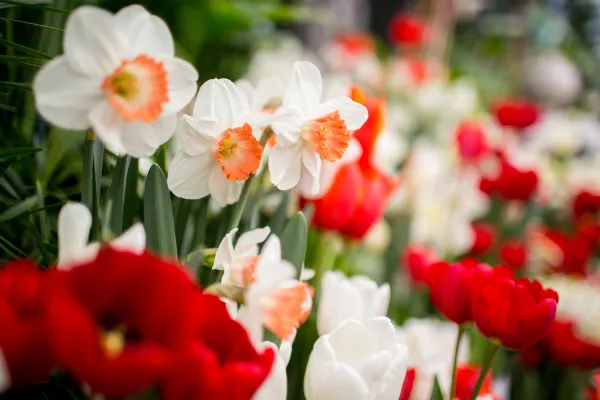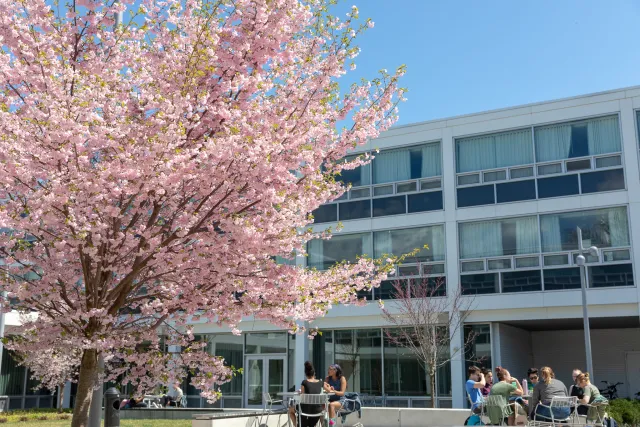An Enduring Landscape
Botanic Garden - Leaflet
Leaflet 2020

Published June 5, 2021
When Sophia Smith left these instructions for the founding of Smith College, she proposed a new institution in the community of universities all over the world that had educated the leaders of their individual societies. From the Renaissance onward a major university would create a botanic garden as a scientific institution for the formal study of plants and, in particular at that time, their medicinal uses, one of the purviews of monastery gardens that preceded them. In his 1891–92 report to the College concerning the new campus design by Olmsted, Olmsted & Eliot, Smith’s first president, Laurenus Clark Seelye, called for “an ornamental botanic garden, the plants and trees being selected and grouped according to scientific as well as aesthetic demands.” He had already visited the Royal Botanic Garden in Edinburgh, thus observing the value of such an institution at first hand. Also, botany had been taught at Smith since the first year of classes. Seelye understood the challenges of creating a curriculum and facilities that would meet those standards required for education in the arts and the sciences to prepare women for leadership positions in their fields.
The completion of Lyman Plant House in December 1895 marked the formal beginning of the Botanic Garden of Smith College. The company Lord & Burnham designed a complex of glasshouses in a Victorian Gothic motif with a balloon-style Palm House that became a timeless landmark on campus, especially illuminated jewel-like at night. With its expansion in 1981 into a range of eleven individual but joined glasshouses, each one planted according to its botanical or climatic family, and its restoration in 2000–2003, the conservatory now offers one of the most fascinating and fragrant promenades at any season, but especially in winter when one sees the bleak world outside through frosted panes.

As a sociology major focused on being accepted for the Junior Year Abroad in Geneva and then to completing my studies on my return, sadly I did not have Lyman Plant House in my sights when I was at Smith. But the year in Europe did open the garden world to me: André Le Nôtre’s landscapes at Versailles and the Tuilleries in Paris, along with château gardens along the Loire River, and the mountainous wildflower fields of Switzerland. Not long after completing my graduate work in French literature at Columbia University, I attended a lecture by the landscape architect and ecologist Ian L. McHarg, in which he defined “the reassuring landscape” as cherished scenes from childhood that we continually seek out or re-create later in life. This lecture struck a deep chord in me, so that when, a few years later, my husband Frederick Morgan suggested I should start writing beyond an occasional book review, my first article was on the significance of the garden in Nathaniel Hawthorne’s House of the Seven Gables, which he based on a garden of his own in Concord, Massachusetts, described in his American Notebooks.
Once I began writing about gardens, I could not stop visiting them, and these excursions took me to the world’s botanic gardens, especially first to the Royal Botanic Gardens, Kew, and its own 1848 balloon-style Palm House, itself a technological breakthrough with its lofty heights and large, unsupported expanses of curved glass. It was then under threat, and I wrote about it for Vanity Fair. As a result of my visits, I understood what I had missed during my years at Smith, and I have been making up for it ever since. When I was asked to join a Media Relations Committee for the college in the 1980s, I suggested that the botanic garden should be publicized as a major feature of the college since so few American universities have a comparable scientific facility that includes a Systematics Garden, a Rock Garden, a Herbarium of mounted plant specimens, and a seed exchange with an annual catalog, the Index Seminum, distributed worldwide.
Shortly thereafter, I met the landscape architect Susan Cohen ’62 at a garden conference, who suggested that landscape architecture, which had once been prominent in the curriculum, should be reinstated at Smith, and we began working together to make this hap- pen with the blessing of Smith’s president Mary Maples Dunn. As a result, Mary Dunn asked us to become the founding co-chairs of the Friends of the botanic garden of Smith College and to organize a symposium on landscape architecture for alumnae and students during the academic year. The first symposium, “Design and Nature,” featuring alumnae speakers, was held in 1992, followed by three others including “The Glasshouse” to celebrate the botanic garden’s centennial in 1995. In the meantime, we were engaged with faculty to create the interdepartmental Landscape Studies Program and raise the necessary funds.
During the Centennial year, Susan Cohen proposed and organized a series of Smith College garden parties with lectures, tours, and programs in multiple U.S. cities and in countries throughout the world, including Cana- da, Japan, and Australia. A high point was a Garden Party Grand Tour that began with secret gardens in Venice, Italy, and proceeded to grand receptions in the gardens of the U.S. ambassadors’ residences in both Paris and London. At the Geneva event, I joined alumnae gathered at the city’s Conservatoire et Jardin botaniques to plant a tulip tree (Liriodendron tulipifera) and felt that I had come full circle.
About that time, I read Edith Wharton’s 1903 Italian Villas and Their Gardens and was intrigued by her diagram in concentric circles of the 1545 oldest university botanic garden in Padua. It was a thrill eventually to walk around those circular beds that made the diagram come to life and that became the format of public gardens elsewhere. I also visited the botanic gardens of Oxford and Cambridge universities, offering the former a century plant (Agave americana) as a gift from Smith, also in recognition of our Centennial.
Now at the 125-year mark, with Tim Johnson at its helm as the seventh director, the Botanic Garden is thriving with all its parts flourishing: 3,200 species in Lyman Plant House, nearly 60,000 mounted specimens in the Herbarium, 12 different plant classifications in the Systematics Garden, and 800 different types of alpine, dwarf, and woodland plants in the Rock Garden. Like botanic gardens everywhere, in addition to being the Noah’s Ark of the plant world, ours is focusing on issues of conservation, biodiversity, and sustainability. Under Johnson, efforts are being made for regional seed banking as well as seed germination and propagation involving students in the collection process. And to make the campus operation more sustainable, he is concerned about its carbon footprint and climate adaptation and resilience with regard to plant material.
Over its history, Smith had close connections with the Royal Botanic Gar- dens, Kew. Smith’s first head gardener, Edward J. Canning, who had worked on the innovative rock garden at Kew that evoked European alpine regions, in 1898 constructed an equally creative rock garden at Smith on an embankment outside Lyman, probably one of the first in America. Since 1994, the botanic garden has maintained a connection with Kew by sending annually two Smith College students as summer interns to work with scientists there on DNA plant research under the auspices of the Muriel Kohn Pokross Class of 1934 Travel/Internship Fund. Many of them have continued their research earning graduate degrees in the field or are engaged in related professions.
Every incoming Smith student is greeted at Lyman Plant House with a gift of an ivy plant, a gesture mirrored at commencement by the ritual planting of ivy by the graduating class. And with a curriculum rich in botany, horticulture, and plant physiology, students actively participate in botanic garden programs and goals. Recently at Lyman, I barged in on Gaby Immerman’s horticulture class where lined up at each student’s place at a long table were one broadleaf and two coniferous evergreens for study. Then in the adjoining room were piles of boughs of these evergreens, along with truckloads of red twig dogwood, winterberry holly, catkins, and dried grass plumes collected around campus by garden personnel, so that students could wire up elaborate and artistic holiday wreaths to take home—winter gardens of another kind.
Students and faculty, as well as the local community and out-of-town visitors, flock to Lyman Plant House especially during the two seasonal flower shows: the Spring Bulb Show in March and the Fall Chrysanthemum Show in November. Preparations are hidden away out of sight for the months-long propagation of the myriad spring flowers, with a perfume beyond belief, as well as for the cascades of chrysanthemums for which the autumn show is famous. Also displayed at the Chrysanthemum Show are the individual hybrid plants created by students in an annual competition that has taken place since 1900, when horticulture entered Smith’s academic curriculum.
Beyond the gardens surrounding Lyman Plant House, the botanic garden features several others on the 125- acre campus including Capen Garden with its romantic pergola supporting climbing roses and a knot garden that demonstrates gardening methods and design, a terraced garden sloping down from the President’s House to picturesque Paradise Pond, and a Japanese Garden just below a woodland planting of rhododendron and native wildflowers. And throughout, old towering trees bearing botanical labels form the complementary extensive campus arboretum.
But for me, whenever I am on campus at any season, I take my customary walk through the glasshouses where the beauty of the scientific order at Smith far excels any purely ornamental arrangement in public gardens. (The research houses are closed to the public.) I always begin in Warm Temperate House with its collection of citruses and gesneriads, continue along Stove House, where orchids hang above a central water tank featuring aquatic plants, and then step up into the towering, humid jungle of Palm House with its famous chocolate tree (Theobroma cacao). Elevated across the way is Cool Temperate House with plants grouped by continent including the tree fern (Dicksonia antarctica) from Tasmania. I begin my descent through Fern House, with its cycads and ferns, into Show House, a scented collection of salvia, pelargoniums, and a pair of old flowering olive (Osmanthus fragrans), before reaching the more structured desert floras in Succulent House.

As I leave behind the moist fragrance of that experience, I like to think that if leadership by women was one of Sophia Smith’s ultimate goals, the Botanic Garden of Smith College has achieved it by educating generations of students who take their new knowledge and make a better world.
Paula Deitz ’59, is editor of The Hudson Review, a magazine of literature and the arts. She is also a cultural critic in the fields of art, architecture and landscape design for magazines and newspapers here and abroad. Her book, Of Gardens: Selected Essays (Penn Press) is available as an audiobook.